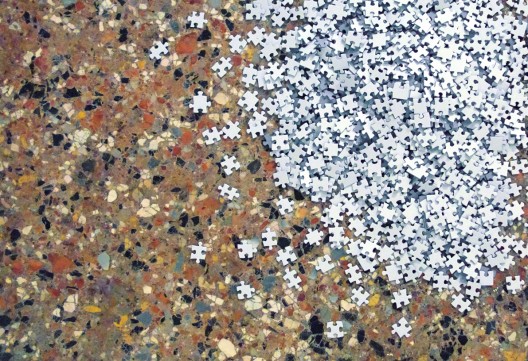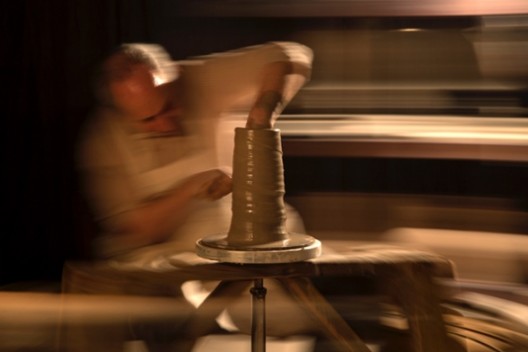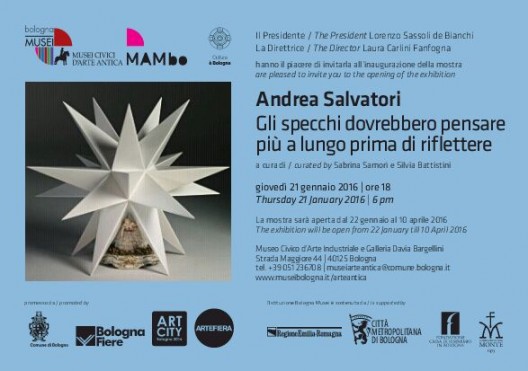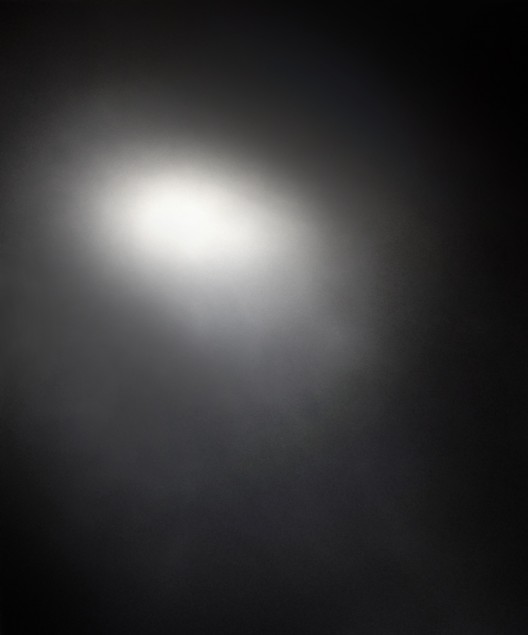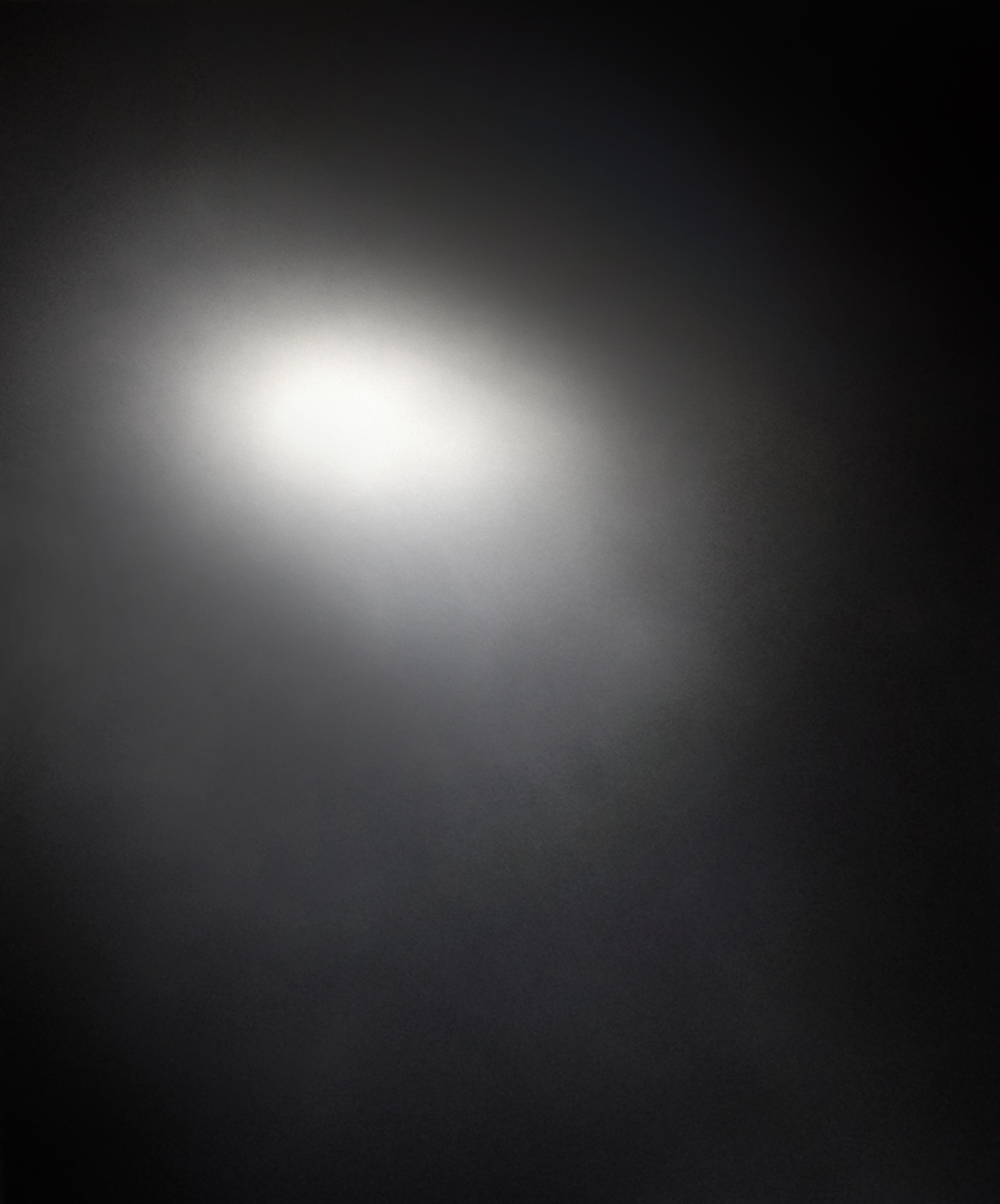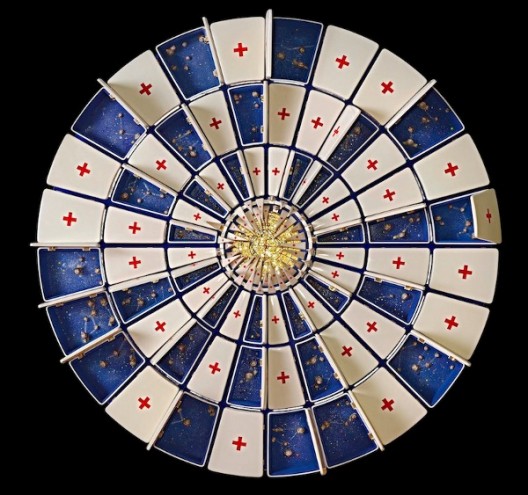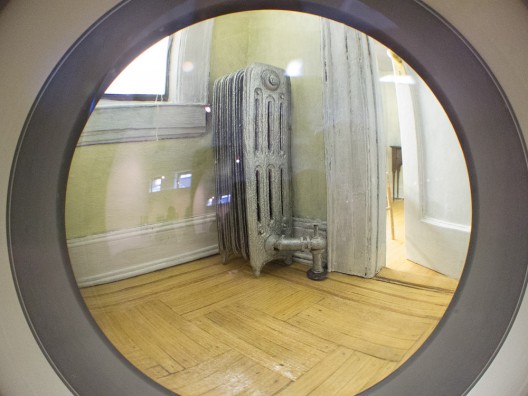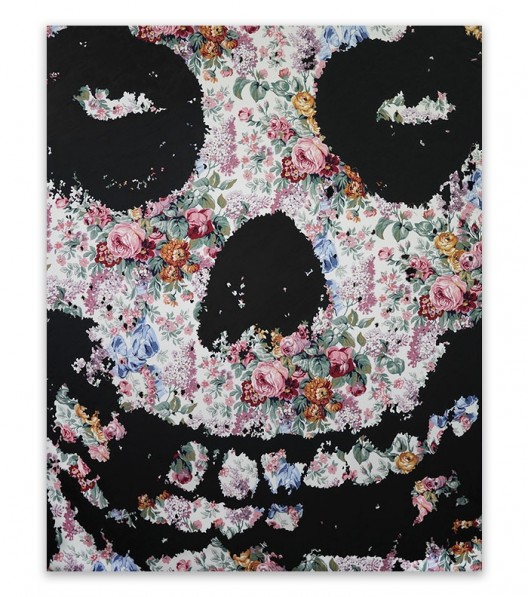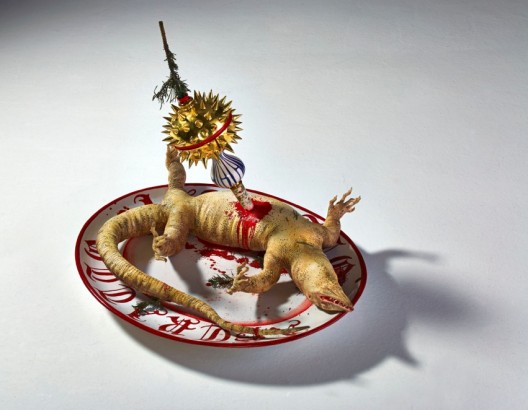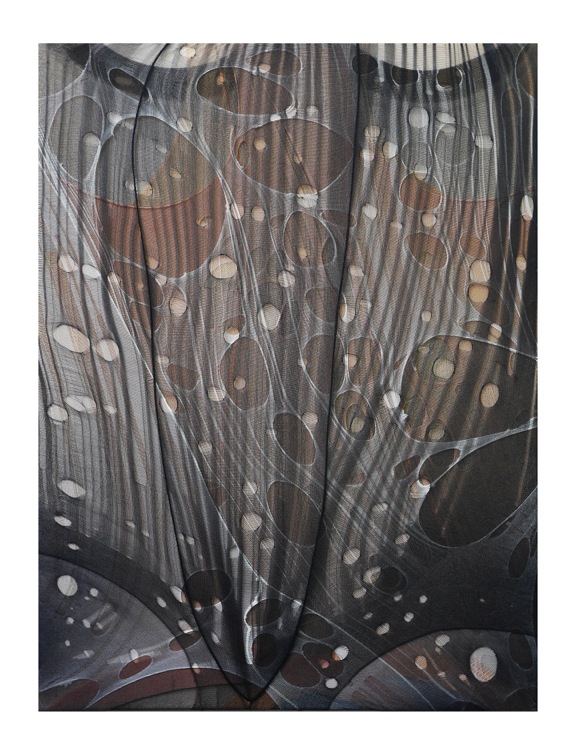On the occasion of the 15th Architecture Biennale, the art gallery THE POOL NYC is coming back to Venice with Show on Show, a solo exhibition by Stefania Fersini.
The show will run from 25th May through 27th November and it will take place at Palazzo Cesari-Marchesi, located in the Calle Rombiasio in Campo Santa Maria del Giglio adjacent to Piazza San Marco.
Stefania Fersinis intervention will happen in a space with historical connotations, following the installations at Casa Mollino and Casa Fornasetti.
The XVIII Century palace bears the signs of a range of architectural and decorative additions reflecting different times. Abandoned for 30 years the palace is now stripped and walking through it one can perceive a great past.
Show on show presents the place in its own place, generating a temporal perceptive and cognitive loop. It is a silent action to let space and time talk.
The artist has created for THE POOL NYC a work requesting the viewer’s participation.
Stefania Fersini scatters in the halls of the palace ten puzzles laid on recovered furniture. The visitor, finding empty seats, is invited to play the game, combining tile after tile of still unknown images.
The representation is exactly what the eyes can see while looking at the puzzle, but there are two main differences compared to reality: the first one is the temporal character, as the puzzle is still a messy pile of cards; the second one is the content: the tiles represent nothing, are white, without a subject.
Fersinis site specific installation could be considered as a tautological gesture for the inherent desire to reveal on the puzzle what the eye can see during the composition of the puzzle itself. It involves the viewers interaction and in order to build the puzzle, she does not provide the resulting image, but the reality itself that is represented in the work. The “player” will find a fragmented reality broken in his hands. Its a mise an abyme that needs to be defined and confirmed.
The subjects are perceived as matter in its details: colors, portions of the pavement, walls, and wood.
The artist plays with our perception and let us reflect whether reality comes first than representation.
Fersinis work questions time, which alludes to a becoming, at times perceived as destroying, in other as creating.
She expresses her critical relationship with the destroyed image, and asks the viewer to engage in the creation of the work.
The puzzle execution emulates the painting practice, chosen by the artist.
Its her choice, and for herself.
We need time to solve problems and its our own time that leads us to the knowledge.
Her cognitive research focuses again on a missing content.
Following Mirrors at Museo Casa Mollino and Casa Fornasetti, the artists use of the white states a missing visual work, to fill that void.
Fersini adds another piece to her journey, waiting to see if the road has taken the lead sooner or later to fill that white piece.
Stefania Fersini (1982) is an Italian artist.
She studied Product Design (faculty of Architecture) and she became part of Nucleo, a collective of artists and designers, based in Torino, Italy. Her designs have been exhibited worldwide over the past years and in the most important art and design fairs.
In 2012 she started a personal artistic project.
After a creative crisis Fersini became attracted to the meditative aspect of paintings execution (precipitated by The Anxiety of Influence by Harold Bloom, philosopher Gilles Deleuze, and the studies of Lacan specifically relating to the pleasure principle by means of repetition).
Her last exhibitions include a solo show at Casa Mollino, Torino and at Casa Fornasetti, Milano.
Her artwork has been exhibited extensively in Torino, Lucca, Milano, Los Angeles, London, Paris, Koln, New York and San Francisco.
Recently, she has been examining the context in which art is displayed and the exhibition itself as a medium.
This is the first solo exhibition with THE POOL NYC.
The preview will take place on 25th May from 6 to 9 pm.
Address: Calle Rombiasio, Campo Santa Maria del Giglio, 30124 Venezia.
How to find us: Once in Campo Santa Maria del Giglio, walk opposite to Canal Grande, pass the church of Santa Maria del Giglio on the left and Tessitura Bevilacqua on the right, following THE POOL NYC stickers.
Vaporetto stop: S. Maria del Giglio (same stop of the Gritti Palace) Line 1
Water access: Rio de lAlboro (aka Rio de le Ostreghe)
Dates: 25th May-27th November 2016
Hours of Operation: from May 25 to June 12 daily 11 am 7 pm. From June 13 to November 27 by appointment only.
| On Wednesday, 20th January 2016, the Exhibition The Third Meaning. Giuseppe Stampone Sarnath Banerjee, curated by Eugenio Viola and Srinivas Aditya Mopidevi, will open to the public in the premises of the Italian Embassy Cultural Centre, New Delhi.This project was initiated through timely conversation between two curators, and two artists in the framework of a cultural exchange between Italy and India.
The two artists presenting work in this exhibition are Giuseppe Stampone and Sarnath Banerjee. Both artists approach their practice from different realities, whose research and work, though far away from each other, have the practice of drawing, in common. They investigate the contradictions and the restlessness of our times, representing realities, sometimes in a controversial and polemical way. In the practice of Stampone, drawing assumes a cognitive value, as of the ancient great masters of the Renaissance age intending to probe a scientific representation of the World. In this way, his usage of symbols and instruments conceal hidden meanings beyond their appearance, orchestrated in a process that textures the ideas in layers. Architecture of Intelligence (2016), is the site-specific project by Stampone realized during his stay in India as part of an ongoing series of iterations. It is an archive of experience in which Stampone stages an intergenerational dialogue with other artists and cultural figures, in this case with Italian artist Stefano Arienti and his reflections on living. The installation re-assembles found-objects to construct an emotional architecture. It restores the artists personal diary in the form of a metaphorical housing unit, built for holding images in which the impressions of the places visited are condensed and preserved. Here, the viewer is invited to enter, to take part and share the experience it offers. Throughout the practice of Sarnath Banerjee, the process of interlacing the textual and the visual is placed in high importance. This collation is presented within the graphic novel form, which becomes a tool for the artist to intercept history, mythology and popular culture in India and other parts of the world. Banerjee stages fictional situations of real places thereby altering the perception of what they mean to us. His recent project All Quiet in Vikaspuri (2015), is one such account, a tale that narrates the story of a plumber and search for the fictional river Sarasvati and the consequent life journeys this process leads him to. The book recently released to the public is in fact a fictional account that speaks about the water wars of Delhi, while the city heads towards becoming one of the global megapolis. For the first time Banerjee unbinds the book into individual drawings and sequences presenting to the public as an installation. Italian Embassy Cultural Centre, New Delhi 50 E, Chandragupta Marg, Chanakyapuri New Delhi 110021 The exhibition will be open till February 20, 2016 |
Ben Hagaris Potters Will (2015) will be on view at Rose Art Museum, after THE POOL NYC’s presentation in the Ball Room of the exhibition “A Palace with a View” (Veneziam 2015). Potter’s will melds the prehistoric art of pottery making with contemporary video art, reconfiguring primordial myths related to creation and destruction, life and death. In this multimedia installation, organized by Faculty Curator Gannit Ankori, a potters rotating studio is on display as both a physical site and a projected sight, inviting the audience to engage in an immersive experience.
The first part of the video documents the transformation of a lump of clay into a beautiful pot, molded by the masterful hands of Paul Chaleff. The potters wheel like the eye of the storm is strangely still within the whirling set. The next section follows the pots metamorphosis into a clay-covered human being, confronted by the kilns fire. Deliberate allusions range from Adam and the serpent of Genesis to ancient Egypts divine potter Khnum. Additional archetypal references include the four elements (water, earth, wind and fire), geometric symbols (squares that transform into circles) and the tail-biting snake, the Uroboros.
Hagari is the inaugural recipient of The Chami Fruchter Prize, a biennial award presented to an emerging Israeli video artist, administered jointly by the Rose Art Museum and the Tel Aviv Museum of Art. A publication, co-edited by Ankori, will accompany the exhibition.
A cura di Sabrina Samorì e Silvia Battistini
Promossa da Istituzione Bologna Musei
THE POOL NYC è orgogliosa di annunciare la mostra personale di Andrea Salvatori al Museo Davia Bargellini.
Dopo una serie di mostre collettive e personali organizzate dalla galleria, Andrea Salvatori torna a Bologna con una personale al Museo Davia Bargellini.
È una trama di spiazzanti tensioni e paradossali equilibri visivi quella che sostiene Gli specchi dovrebbero pensare più a lungo prima di riflettere, il progetto espositivo concepito da Andrea Salvatori in dialogo con l’eclettico patrimonio del Museo Davia Bargellini.
Con attitudine giocosa, l’artista si confronta con i due nuclei che compongono le collezioni del museo – le raccolte di arti applicate e la quadreria senatoria della famiglia Bargellini – traducendo sul piano della strategia espositiva i meccanismi cardinali del suo fare artistico: la manipolazione di elementi distanti tra loro e lo scarto percettivo generato dalla loro collisione semantica e formale.
La mostra è promossa dall’Istituzione Bologna Musei nell’ambito della quarta edizione di ART CITY Bologna (29-31 gennaio 2016), il programma di iniziative istituzionali promosso da Comune di Bologna in collaborazione con BolognaFiere in occasione di Arte Fiera, che si propone di offrire nuove prospettive di visita al patrimonio storico-artistico della città attraverso opere di artisti contemporanei.
Dal 21 Gennaio al 10 Aprile 2016
Orario standard: dal martedì al sabato: ore 9-14; domenica e festivi infrasettimanali: ore 9-13
Orario ART CITY: venerdì 29 gennaio ore 10-20, sabato 30 gennaio ore 10.30-24, domenica 31 gennaio ore 10.30-20
THE POOL NYC is proud to present Ultraviolet Catastrophe, a solo exhibition by New York based artist James Case-Leal.
This exhibition will include selections of paintings from three unique series on light Sun painting, Black Rainbows, and Invisible Light.
James Case-Leal creates rainbows and celestial bodies linked to the creation of the universe. His paintings are made with numerous layers of paint sprayed on linen canvases stretched over wood. The surfaces are scrubbed and polished to perfection. The effect is extremely beautiful and powerful. You can see many things in these perfect works. They reference moments from the Big Bang to the intensity of Turner to the serenity of James Turrell.
His Sun paintings offer the experience of staring at the sun with all its warmth, brightness, and intensity. In his Black Rainbow paintings he creates a rainbow, the result of sun and rain together, and places it against a deep black background, a space that appears dreamy and mysterious. The White Light paintings are based on invisible light – the light that is outside of our visible spectrum, but surrounds us.
A selection of small porcelain sculptures representing masks and heads are displayed throughout the floor. They evoke anthropology and ground the ethereal experience of the paintings to remind us that we are here with the earth.
The exhibition will take place at Palazzo Cesari-Marchesi in Venice, a palace temporarily transformed in to a gallery for this exhibition. The XVII century Palazzo, with Terrazzo floors and Stucco rooms are a perfect setting for Case-Leals work. The mix of contemporary paintings in this historical building will be mind blowing.
Case-Leal is a Texan born New York based artist, who received a Master of Fine Arts from Columbia University in 2014. He has most recently exhibited in NYC at Marianne Boesky, Fergus McCaffrey, and Franklin Parrasch galleries. This will be his first solo show in Italy.
Venice, 1st September 15th September 2015.
Palazzo Cesari-Marchesi, Campo Santa Maria del Giglio.
The opening reception will take place on 1st September starting from 5 pm.
On the occasion of the 56th Venice Biennale
featuring
Alfredo Barbini, Bertozzi & Casoni, Fulvio Bianconi, Nicola Bolla, James Case-Leal, Eteri Chkadua, Piero Gilardi, Ben Hagari, Patrick Jacobs, Aldo Mondino, Giorgio Morandi, Tim Plamper, Jonathan Rider, Andrea Salvatori, Bianca Sforni, Giuseppe Stampone, Fabio Viale and Ludwig Wilding
at Palazzo Cesari Marchesi
Calle Rombiasio
Campo Santa Maria del Giglio, 30124, Venezia
Opening Reception: Tuesday, 5th May 2015, from 5 pm onwards
5th MAY 30 JUNE, 2015
PATRICK JACOBS ALLE 5 VIE, MILANO. SALONE DEL MOBILE
DISTRICT INAUGURATION
15TH APRIL, 6 PM TO MIDNIGHT
PRESS PREVIEW
MONDAY 13TH, 11 AM TO 3 PM
PATRICK JACOBS WORKS WILL BE ON DISPLAY IN SPECIFIC VENUES IN
THE STREETS OF 5 VIE DISTRICT:
SPAZIO SANREMO, VIA ZECCA VECCHIA, 3 Angolo VIA FOSSE ARDEATINE
STUDIO G, PIAZZA SANTAMBROGIO, 16
ETHNOARTE, VIA SAN GIOVANNI SUL MURO, 21
BECARA, PIAZZA MENTANA, 3
ALL THE ART WORKS WILL BE VISIBLE 24 HOURS A DAY.
YOU WILL FIND THEM WALKING ALONG THE DISTRICT.
THE POOL NYC gallery is proud to present Patrick Jacobs first solo exhibition in Italy.
The artist has been included in American Dreamers at La Strozzina in Firenze in 2012 and in different shows in Venice, Bologna and Rome organized by the gallery.
Patrick Jacobs work on view in Milan at 5 VIE consists of a meticulously constructed diorama installed within the hidden architecture of the wall and viewed through a circular window of glass lenses.
The luminescent portholes by Jacobs are proper light boxes functioning through a LED light and two convex lenses that create an illusionary depth.
Viewers will look at Patricks mysterious works installed along the 5 VIE district.
The landscape works take their name from the popular Ortho Books for home and garden care, while the interiors are based on the artists apartment in New York. These series blur perceptual distinctions between painting, photography and constructed reality.
Jacobs works will create a contemporary art itinerary in the oldest neighborhood of Milan. They will be visible night and day by looking into the peepholes along the designated path. Visitors in Milan will have the same experience of New Yorkers walking by the Museum of Art and Design of New York, where Patricks work is permanently installed on the facade.
Patrick Jacobs (1971) is an American artist who lives and works in Brooklyn, NY.
His work has been exhibited worldwide. Selected Exhibitions include: 2015 Come closer to me, Pierogi, Brooklyn, NY , 2013 WIDE SHOT, THE POOL NYC, Biennale di Venezia, Venezia, 2013 On Time/Grand Central at 100, MTA Arts for Transit Gallery,New York, NY, 2012 Interiors: From Within Outward, THE POOL NYC, New York, NY, 2012 Otherworldly, Des Mondes Irreels, Musée des Beaux-Arts Eugène Leroy, Tourcoing, France, 2012 American Dreamers: Facing or Escaping Reality in Contemporary Art, Centro di Cultura Contemporanea Strozzina, Palazzo Strozzi, Florence, Italy, 2011 Otherworldly: Optical Delusions & Small Realities, MAD Museum of Arts and Design, NY, 2009 Obsessions, curated by John Zorn, MEM Gallery, Osaka, Japan, 2009 Cream No Sugar, Pierogi, Brooklyn, NY.
MARCH 5-8, 2015
PIER 90
WEST 50th STREET @ 12th AVENUE
NEW YORK
BOOTH C22
Eric Mistretta‘s work utilizes elements of language and popular cultural imagery in compositions that are at once familiar but exist in manipulated, unexpected contexts. Through this process of re-contextualization, identifiable images are infused with a new sensibility, and the resulting hybrids elicit both feelings of familiarity and a sense of absurdity.
In works such as Ninety Poems by Robert Frost, Mistretta’s homage to the twentieth century author who tirelessly avoided innovation by relying on traditional forms of nineteenth century poetry, the artist depicts the non-existent title of Frost’s imagined volume in the style of a 1990’s Newport cigarette advertisement. These ads are most remembered for conveying a heavily manufactured sense of excitement and enthusiasm, which culminated in the “Alive with pleasure!” campaign. InNinety Poems by Robert Frost, Mistretta deploys Newport’s advertising strategy to instill the painting with a sentiment deliberately at odds with Frost’s sobering, rural poetry.
In one of the artists new series of paintings for VOLTA NY 2015, Mistretta explores his interest in floral-printed textiles, using them as visually rich backdrops for additional painted imagery. The patterned, cotton fabrics strike a dynamic note of depicting something natural through highly synthetic means. Their associations, which range from fashion to bedding to decoration, all serve as catalysts for further transformation through the incorporation of additional content.
Image:
Eric Mistretta, Fiend Club (Purgatory), 2015, Oil pastel and wax crayon on printed cotton over canvas, 60 x 48 in.
THE POOL NYC a Palazzo Sassoli de Bianchi, Via Farini, 14 Bologna 22?26 Gennaio 2015
Nel Rinascimento la bottega era il luogo dove l’artista creava la sua opera e la eseguiva grazie all’aiuto di vari collaboratori; tra questi discepoli ce ne era spesso uno che si distingueva per tecnica, estro e desiderio di imparare, ma soprattutto di andare oltre cio? che creava il maestro.
La mostra ALLIEVO e Maestri. Andrea Salvatori e Bertozzi & Casoni vuole evidenziare il lungo sodalizio di lavoro e d’amicizia che esiste tra il giovane Salvatori e i due maestri della ceramica Paolo Bertozzi e Stefano Casoni.
Andrea Salvatori e? stato nella bottega (che in tempi attuali viene chiamata studio) dei due scultori di Imola fin da giovanissimo e ne e? diventato il direttore, fino ad arrivare oggi a collaborare per progetti speciali.
Salvatori, vincitore per due volte consecutive del Premio della Ceramica Internazionale di Faenza (2007-?2009), trova oggetti nei mercati antiquari e li accosta a sculture di ceramica eseguite a mano nello studio di Solarolo. Agli esordi della carriera l’artista creava scene quasi fumettistiche che diventavano sculture in ceramica, mentre nei lavori attuali la concentrazione e? piuttosto sull’estetica finale dell’opera, senza perdere pero? il senso dell’umorismo di cui Andrea Salvatori e? uno dei massimi esponenti. Se all’inizio l’artista ridicolizzava l’uso di statuette e oggetti di ceramica e porcellana delle case degli anni ’50 e ’60 trasformandoli in giocose scenette scultoree, ora si concentra nel convertire oggetti talvolta assai banali in punti di partenza per la creazione di urne, vasi e grandi sculture. Ne e? un esempio perfetto la serie TUTTITAPPI 2014-?15 in mostra a Bologna.
Bertozzi & Casoni in maniera iperrealistica e assai ironica raccontano il mondo moderno con un materiale antichissimo, la ceramica, e lo illustrano attraverso gli scorci che di solito sono da nascondere. Le cosiddette Sparecchiature, montagne di stoviglie sporche con resti di mangiare, i cestini con pacchetti finiti di sigarette, pasticche consumate, pile e animali che vi capitano casualmente sono due esempi di una poetica estetica, brillante nei colori e negli accostamenti e nel disvelamento della realta? proibita, ma che si vuole tuttavia esaminare. Le ceramiche di Bertozzi & Casoni sono un viaggio nel mondo attuale, uno studio della psicologia dell’uomo d’oggi, sia quando si vede la Vergine che taglia l’erba, sia quando il gorilla su un materasso siede beato intento alla lettura. La ceramica e? leggera, “niente e? come appare”, recitava il titolo di una vecchia mostra dei maestri di Imola. Effettivamente la ceramica e? talmente sfavillante, precisa, reale e bella, che non sembra essere quel materiale utilizzato per i piatti di ogni giorno.
Nella suggestiva cornice di Palazzo Sassoli de’ Bianchi, in Via Farini 14, proprio dove la Meridiana di Montanari, la piu? antica di Bologna attraversa l’edificio, negli spazi della cappella e in altre sale del piano nobile, la galleria THE POOL NYC presenta le ceramiche di Salvatori e di Bertozzi & Casoni che potranno dialogare con gli affreschi raffiguranti le Storie della Vergine di Giovanni Battista Cremonini.
“Non c’e? niente da fare: ogni maestro ha un solo allievo e questo gli diventa infedele perche? e? destinato anche lui a diventare maestro” scriveva Nietsche. Questa e? anche la storia di Salvatori con Bertozzi & Casoni.
Il nuovo Premio Lissone
Nel 2000 l’Amministrazione Comunale di Lissone, inaugurando il Museo d’arte contemporanea – denominato Civica Galleria d’Arte Contemporanea fino al riconoscimento ufficiale dello status di “museo” da parte della Regione Lombardia (2003) – ha finalmente radunato in una sede appropriata le importanti opere di sua proprietà acquisite nel corso degli anni in cui la città fu luogo significativo a livello internazionale per la documentazione della ricerca artistica europea.
Mi riferisco agli anni tra il 1946 e il 1967, durante i quali si tenne in città il Premio Lissone, iniziativa che coinvolse assieme agli artisti emergenti, i critici e gli storici più qualificati d’Europa, e permise di riconoscere e dare evidenza con i suoi premi ad artisti che negli anni immediatamente successivi avrebbero trovato riscontri ancora più alti nella rassegna più prestigiosa del mondo, la Biennale Internazionale di Venezia.
Le opere acquisite in quegli anni costituiscono ora una prestigiosa collezione che può vantare le “firme” di Adami, Appel, Birolli, Bellegarde, Bertrand, Boyle, Bruning, Buri, Damian, De Gregorio, Dufrêne,Crozier, Dorazio, Faesi, Feito, Francese, Guinovart, Hugues, Klasen, Marfaing, Moreni, Morlotti, Murtic, Nikos, Perilli, Pisani, Reggiani, Romiti, Ruggeri, Scanavino, Schifano, Schneider, Soffiantino, Tapies, Vedova, Verhoog, Werner.
L’esperienza di quel Premio Lissone si concluse nel 1967 con l’edizione vinta da Valerio Adami, ma il ricordo di quel fervore organizzativo e degli stimoli culturali proprio dell’evento rimanevano vivi in quanti vi avevano partecipato e sollecitavano quanti ne venivano a conoscenza.
Così nel 1999 si fece un primo tentativo di riannodare un filo considerato definitivamente interrotto saggiando la situazione con un Premio di pittura Città di Lissone, che nei due anni successivi divenne Premio d’Arte Città di Lissone. Furono queste le premesse per una ripresa definitiva del Premio Lissone, che assunse nuovamente la denominazione d’origine, grazie alla disponibilità della Famiglia Artistica Lissonese, depositaria del titolo in quanto organizzatrice delle prime edizioni del Premio stesso.
Il 2002 è quindi la data ufficiale di ripresa definitiva del Premio Lissone, che all’inizio ha avuto una cadenza annuale e che, a partire dal 2006, comincia ad alternarsi con il Premio Lissone Design, rivolto ai giovani creativi nel campo del design appunto, che nella sua prima edizione vede una partecipazione molto ampia raccogliendo ben 238 progetti provenienti da 23 nazioni.
2002-2005
Il regolamento del nuovo Premio Lissone prevede la partecipazione di artisti invitati da una apposita commissione, composta volta a volta da critici o direttori di musei, che segnalano autori secondo loro meritevoli di particolare attenzione.
Una giuria appositamente nominata individua poi l’opera da acquisire per la collezione del Museo cui viene assegnare il Premio Lissone.
La giuria ha anche la facoltà di individuare tre ulteriori opere cui vengono riconosciuti dei “premi di stima”.

